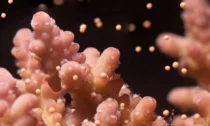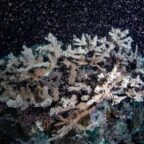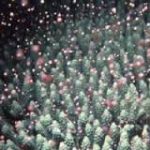
Coral spawning is a natural wonder. It’s also a pain in the neck for coral researchers. Once a year, at a time determined by a combination of water temperature, the length of the days and the phase of the moon, coral across a reef release buoyant bundles of eggs and sperm into the water. The effect resembles an upside-down snow globe, a blizzard of little pearls rising toward the surface.
The event is magical. And, for scientists, it triggers a crazed late-night frenzy of trying to collect enough eggs and sperm to last them through a year of experiments, until the next spawning.
Now, researchers in Australia have joined a select few labs around the world that have figured out how to trigger spawning on a human-made schedule. The breakthrough at Australia’s National Sea Simulator, or SeaSim, announced August 22, is a critical step in the push to grow coral on a massive scale to help save the country’s Great Barrier Reef as its ravaged by climate change.
“The thing that stands out most for me with this program is the scale at which we are trying to industrialize and operationalize the production of corals,” said Carly Randall, an ecologist with the Australian Institute of Marine Science who as involved in the spawning project. “We are trying to create a system that will create corals 12 months out of the year.”
In other words, they want to farm coral.
The scale of the vision speaks to the size of the problem. Coral reefs harbor an estimated quarter of all ocean species. But they are imperiled by rising ocean temperatures, as well as pollution and acidification of ocean water. During underwater heatwaves, coral polyps expel tiny algae that live in their tissue. The algae are a key source of nutrients for the polyps, which resemble tiny sea anemones. The loss of the colorful plants causes the corals to turn bone white, a phenomenon known as bleaching. If the problem persists, the corals can starve to death. Scientists estimate the world’s coral reefs could decline by as much as 90% in the next 20 years as a result.
Stemming greenhouse gas pollution is the key to addressing the problem. But coral researchers in recent years have embraced more direct interventions, as greenhouse gas levels continue to rise in the atmosphere.
Much of the work revolves around trying to breed more heat-tolerant coral. But doing the research, not to mention applying any results on a scale that could rebuild reefs, requires producing a lot of coral polyps and studying their genetics.
In 2018, I had the good fortune to witness coral spawning at SeaSim. As darkness fell, tiny packets of coral DNA began floating to the top of aquarium tanks. People carefully scooped them into plastic cups. Some rushed the bundles to a room where sperm and eggs from different corals were sorted and mixed in rows of bowls to create hybrids. Others scurried upstairs to another room where coral sperm was frozen for safekeeping. In another building, a lone scientist hunched over a microscope, using a delicate needle to inject a genetic modification into freshly-fertilized embryos, to study which genes effect heat tolerance. Several people commented on how great it would be if they could control the timing of the spawning, rather than rushing across the globe for these once-a-year extravaganzas.
Just the year before, in 2017, Jamie Craggs, a scientist at the Horniman Museum and Gardens in London, published a paper describing the first success at artificially-induced coral spawning in a lab.
Now, five years later, a number of labs are following Craggs’ lead. “This type of technology is revolutionizing our work,” said Phillip Cleves, a coral geneticist at the Carnegie Institution for Science in Baltimore, Maryland. He was the one peering through the microscope at coral embryos in 2018. When he spoke several weeks ago, he expected coral to start spawning in his lab within days. “If we can just get coral spawning like this week in Baltimore, we can now do many, many more—probably exponentially more—experiments.”
At the Australian lab, in the newest accomplishment, six species of corals were tricked into spawning during the Australian winter, six months out of sync with the corals on the Great Barrier Reef. The corals that spawned had spent their entire lives in the lab, conceived during the 2014 spawning.
“These corals have never been exposed to natural environmental cues. They have been raised under artificial conditions all their lives,” said Lonidas Koukoumaftsis, SeaSim’s senior aquarist.
In four of those six species, the artificial spawning produced larvae that then successfully started new coral colonies of their own.
Jonathan Daly, head of a coral cryopreservation program in Australia who was also at the 2018 spawning, said he would be interested in studying the quality of the sperm from these new, induced-spawning events. As scientists rush to figure out how to create a coral aquaculture system, “anything that increases capacity is something that’s going to be a multiplier across a bunch of different research programs,” he said.
For now, however, the natural cycle is still the main show. Daly is already looking ahead to the spawning that will kick off shortly after the sun sets one night in November or December. “We’re starting to ramp up,” he said.
Photo: Marie Roman, Australian Institute of Marine Science














Social Profiles